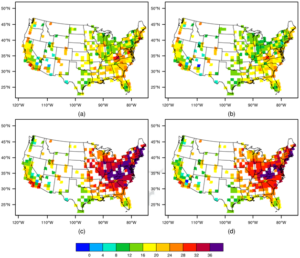UT’s Air Quality and Climate Group, led by Professor Joshua Fu in collaboration with Research Professor John Drake and doctoral student Jian Sun, found a way to speed up an Earth System Model to improve air quality prediction of ground-level ozone. Since the ground-level ozone is one of the six criteria pollutants defined by the U.S. EPA, having a better prediction of surface ozone concentration is crucial for assessing associated impact on public health and crop production.
Previous studies mainly focused on the improvement of emission inventory and grid resolution to obtain a better prediction of surface ozone concentration. These improvements are beneficial at a regional scale, but

Figure 1. The total wall-clock time (unit: second) per processor for a 5-day simulation. (Blue: first-order implicit solver; Red: ROS-2 solver).
global-scale high-resolution models of ground-level ozone formation require enormous computational resources. Professor Fu, an expert in emission inventory, regional air quality modeling and climate modeling, asked two important questions to improve the prediction: 1) Is it possible that there exist some deficiencies inside a main chemistry-climate model, CAM4-Chem, and 2) Can the model be sped up for more sensitivity runs?
To attempt to answer this, the team incorporated the second-order Rosenbock numerical solver (ROS-2), into the Community Earth System Model (CESM), a NCAR/DOE model. The atmospheric chemistry component of the CESM, CAM4-Chem, is a widely used global chemistry-climate model with active atmospheric chemistry that considers interaction among the atmosphere, land, ocean and sea ice. In the state-of-the-art version, CAM4-Chem yields low computational speed for the chemistry, which prevents the scie

Figure 2. 10-year averaged (a) annual and (c) summertime mean surface ozone concentration bias (unit: ppb) over the CONUS between the first-order implicit solver (ORI) and the AQS observation data (ORI minus AQS). (b, d) The same but for the ROS-2 solver.
ntists from running comprehensive sensitivity analyses of the model. In addition, the surface ozone concentration over the conterminous U.S. (CONUS) are over-predicted using CAM4-Chem.
“The ROS-2 numerical solver has already been used in the regional air quality model and global chemistry-transport model, so we are very curious about its effect on the global climate simulation with online chemistry,” said by Fu. A ten-year simulation (from 2001 to 2010) using a horizontal resolution of 0.9° x 1.25° and 26 vertical layers were compared using original first-order implicit solver and ROS-2 solver, respectively. The simulations consumed about 400,000 computational hours on Titan at the Oak Ridge National Laboratory, which is the fastest supercomputer in the U.S.
“We have found that the ROS-2 solver has saved around 47 percent of total computational time for the chemistry update, and this computational speedup is stable for the long-term simulation,” said by Fu. “We expect that the ROS-2 solver is intrinsically faster than other iterative solvers like the one currently used in CAM4-Chem.”
In addition, the positive bias of surface ozone concentration over the CONUS is clearly reduced by the ROS-2 solver, especially in Eastern U.S. where the highest biases exist, and during the summertime season when the photolysis reaction is the most active. It is further reported that the bias of surface ozone concentration in Europe and Asia are also reduced, which suggests that the improvement of model performance over the CONUS is not a trade-off against increasing the bias over other global continents.
“We are so excited that the ROS-2 solver has brought significant improvements of computational performance and predication ability for the chemistry update in CAM4-Chem,” said by Fu. “It is a promising alternative that enables us to do more sensitivity simulations about chemistry given the limited computational resources and provide a better prediction of surface ozone concentration that can be further linked to the impact analysis.”
Currently Fu’s research group is further investigating the numerical behavior of ROS-2 solver on the atmospheric chemistry and its potential portability to the latest computational architecture.